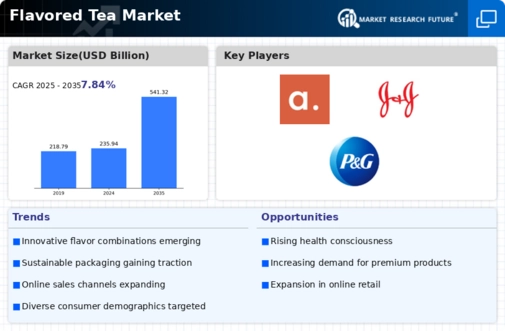Market Share
Flavored Tea Market Share Analysis
The Flavored Tea Market is a diverse and dynamic sector where market share positioning strategies are pivotal for brand success. A foundational strategy within this market is flavor diversity. Recognizing the evolving tastes of consumers, brands consistently introduce a wide array of unique and exotic flavors to stand out. Whether it's floral infusions, fruit blends, or innovative herbal combinations, the goal is to capture the attention of tea enthusiasts seeking a delightful and aromatic experience. Flavor diversity allows brands to cater to different preferences and attract a broader consumer base. Pricing strategies are critical in the Flavored Tea Market, with brands often adopting a tiered pricing approach. Premium offerings emphasize high-quality tea leaves, sophisticated flavor profiles, and elegant packaging to appeal to consumers willing to pay a premium for a luxurious tea experience. On the other end, budget-friendly options target a wider demographic, making flavored tea accessible to those looking for quality at an affordable price. Striking the right balance between quality and affordability is essential for building a strong market position. Distribution channels play a crucial role in the success of flavored tea brands. Establishing strategic partnerships with supermarkets, specialty tea shops, cafes, and online retailers ensures widespread availability. Many brands also leverage e-commerce platforms to reach a broader audience. An effective distribution strategy is key for meeting the diverse shopping preferences of consumers and expanding market reach Innovation is a driving force in the Flavored Tea Market, with brands investing in research and development to introduce novel tea blends and brewing methods. This includes incorporating health-focused ingredients, such as antioxidants or adaptogens, to align with consumer wellness trends. Sustainable packaging and eco-friendly practices also contribute to a brand's appeal. Staying ahead of emerging health and environmental trends allows brands to position themselves as leaders in the market. Marketing and branding strategies play a significant role in shaping consumer perceptions within the Flavored Tea Market. Brands often focus on the health benefits of tea, promoting attributes such as antioxidants, relaxation, and digestive aids. Engaging storytelling, visually appealing packaging, and collaborations with influencers contribute to brand visibility and resonate with tea enthusiasts. The cultural and experiential aspects of tea consumption are often highlighted to create a unique brand identity. Global market expansion is a strategy embraced by some brands to increase their market share. Identifying and entering new geographical markets allows companies to tap into diverse tea cultures and adapt to regional preferences. Customizing flavors to align with local tastes and understanding cultural nuances are essential components of successfully establishing a presence in different markets. Consumer education is a valuable but sometimes overlooked strategy within the Flavored Tea Market. Brands invest in educating consumers about tea varieties, brewing techniques, and the unique characteristics of flavored teas. This not only enhances consumer knowledge but also fosters a deeper appreciation for the intricacies of tea, leading to increased brand loyalty.






Leave a Comment